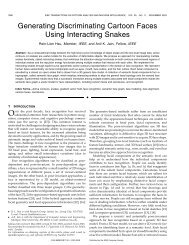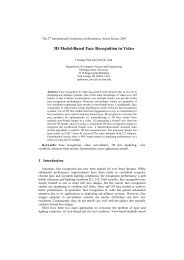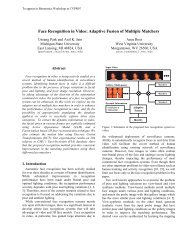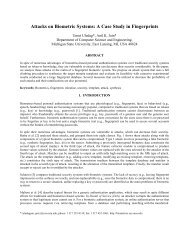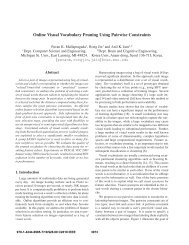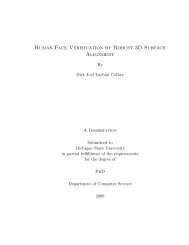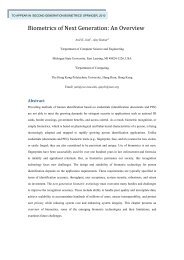Face Detection and Modeling for Recognition - Biometrics Research ...
Face Detection and Modeling for Recognition - Biometrics Research ...
Face Detection and Modeling for Recognition - Biometrics Research ...
Create successful ePaper yourself
Turn your PDF publications into a flip-book with our unique Google optimized e-Paper software.
of Fourier series truncation.<br />
In addition, the coordinates of component boundary<br />
(a) (b) (c) (d) (e)<br />
(f) (g) (h) (i) (j)<br />
Figure 5.3. Semantic face graphs <strong>for</strong> the frontal view are reconstructed using Fourier<br />
descriptors with spatial frequency coefficients increasing from (a) 10% to (j) 100% at<br />
increments of 10%.<br />
of G can also be represented by parametric curves, i.e., c(s) = (x(s), y(s)), where<br />
s ∈ [0, 1], <strong>for</strong> explicit curve de<strong>for</strong>mation or <strong>for</strong> generating level-set functions <strong>for</strong> implicit<br />
curve evolution. There<strong>for</strong>e, the component boundaries of a semantic face graph<br />
are associated with a collection of active contours (snakes).<br />
5.2 Coarse Alignment of Semantic <strong>Face</strong> Graph<br />
Our face recognition system contains four major modules: face detection, pose estimation,<br />
face alignment, <strong>and</strong> face matching. The face detection module finds locations<br />
of face <strong>and</strong> facial features in a color image using the algorithm in [175]. Figures 5.4(a)<br />
to 5.4(d) show input color images <strong>and</strong> the results of face detection. Currently, we as-<br />
115



